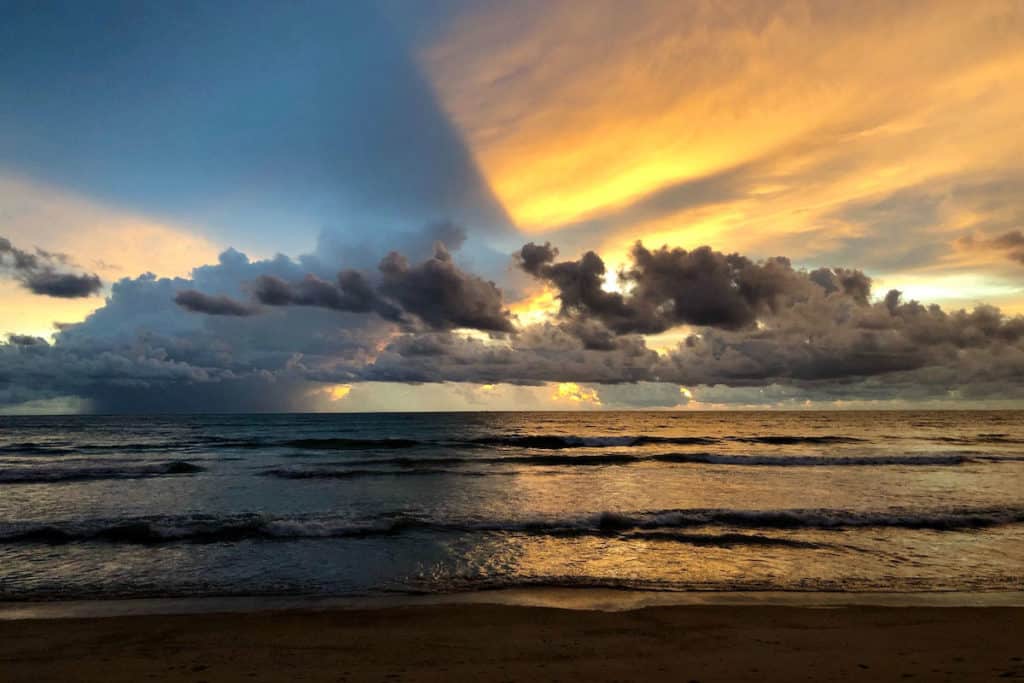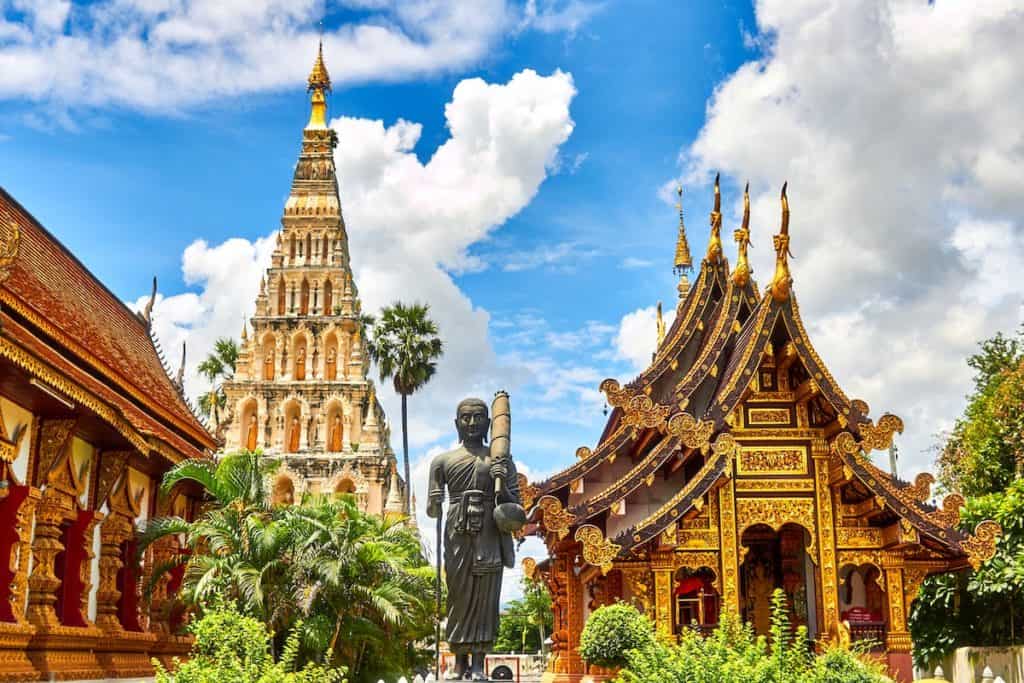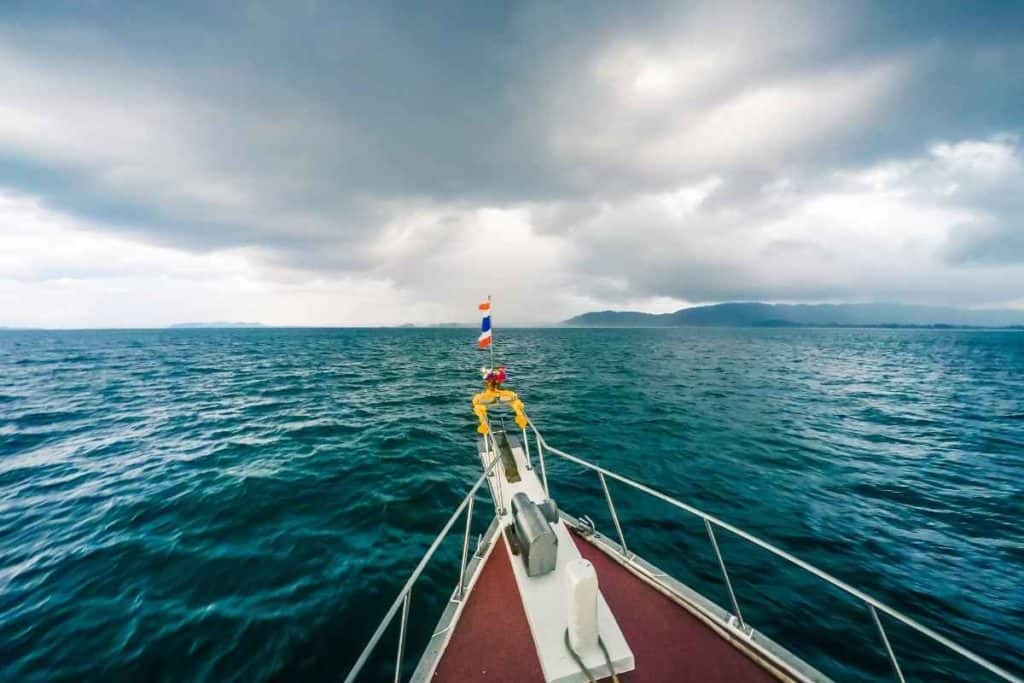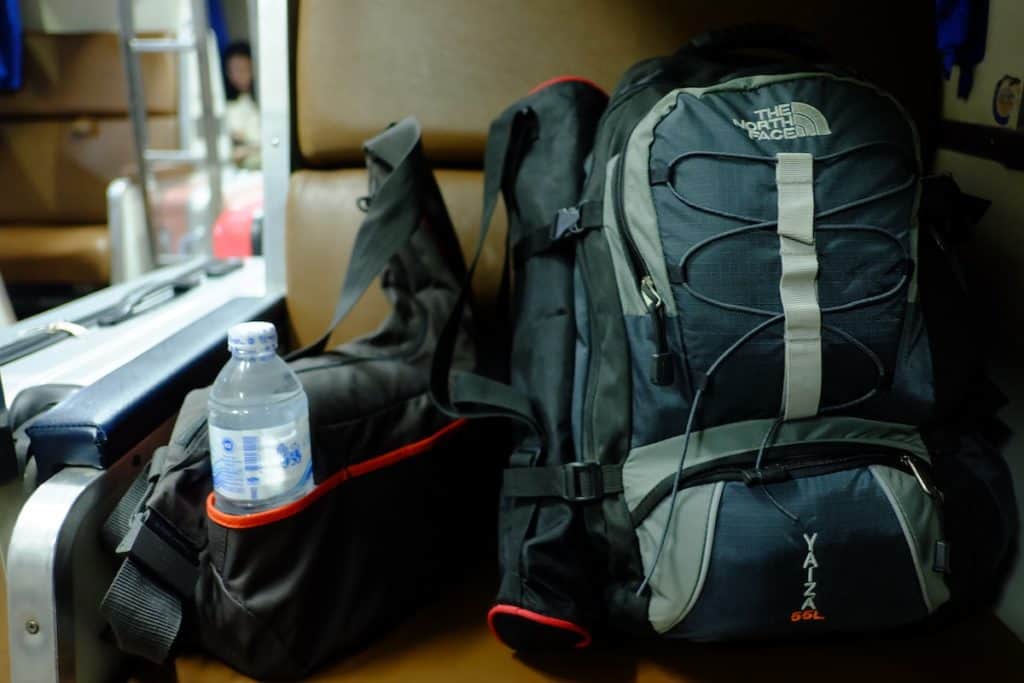Irrespective of the country in question, perhaps one of the most common questions holidaymakers and travelers ask is, when is the best time to visit there?
After all, it makes sense to plan ahead and pick out a date that is most likely to ensure the best experience of your dream destination. The same applies to Thailand.
Located between latitudes 5°37 N to 20°27 N and longitudes 97°22 E to 105°37 E, Thailand can be considered a tropical country. Hence, most people associate hot, humid weather, with clear waters, and exotic islands. Thailand can undoubtedly be considered a ‘tropical paradise.’
However, scorching weather and sunny beaches are not the only things found here. In reality, Thailand has a range of weather climates in different parts of the country.
So, on any given day, the coastal areas in the south and mountain areas in the north can have different weather climates and temperatures.
Here is a complete guide to help you assess when is the best time to visit Thailand, based on where you plan to go and what you plan to do. Read on and get those important dates marked off in your calendar.
Climate Considerations

Perhaps one of the first things you should think about is what type of climate you would prefer for your trip, i.e., what weather conditions and temperature aligns with your goals and activities you plan to do.
Let’s face it; if you’re the sun-worshipping beachgoer type, you’re not going to get the most out of your visit to Thailand during monsoon season. Similarly, if you’re the active and adventurous sort, you might want to avoid a month when temperatures peak and wait for when it’s cooler.
Therefore, it’s essential to know about Thailand’s 3 different seasons and what months they occur.
Summer (from mid-February to mid-May):
Known as the pre-monsoon season, this is also the transitional period to the southwest monsoon, from the northeast monsoon. As the transitions happen, the weather becomes warmer, especially in the country’s upper region. The hottest month in the whole year is known to be April (1).
Rainy Season (from mid-May to mid-October):
As the southwest monsoon enters all over the country, an abundance of rainfall happens across Thailand. August to September is considered the wettest period of the year, except the east coast of southern Thailand, where heavy rainfalls remain until the end of the year, the beginning period of the northeast monsoon. In this region, November is considered the wettest month of the year (1).
Winter (mid-October to mid-February):
Winter is considered the mild weather period of the year – in upper Thailand, it can be pretty cold during December and January. However, heavy rainfall remains on the east coast of southern Thailand, especially during the period from October to November (1).
* This is a quick overview. For more information on the climates in Thailand, check out our in-depth article on Thailand weather – from annual data to the factors that influence different weather climates.
What Is The Best Month To Go To Thailand?

The best time to visit Thailand weather-wise is during the winter and early summer when it is cool and dry. From November to early April, the temperature usually ranges from 84-93 °F (29-34 °C) – making it ideal for enjoying all types of activities without sweating a ton under the sun (2).
However, the weather can differ according to the regions, even during the same season. So, here are the climates of each region in Thailand and the best periods to visit them.
Best Time To Visit Bangkok:
The climate is usually hot all year round in Bangkok, the country’s capital city. The weather is nice between mid-November to January, and clear skies can generally be seen during this period. The heat becomes the most intense between March and mid-May, with the highs reaching 100 °F (38 °C).
During these months, the weather remains hot even at night, with the temperature often remaining around 82-84 °F (28-29 °C) (3). Heavy rainfalls happen the most during September and October, so if you plan to visit during these months, bring extra pairs of slippers as floods are very common in this big city.
To avoid steaming hot weather and heavy floods, the best time of the year to visit Thailand and Bangkok would be from December till mid-February as the weather during that period is the least hot and one can enjoy clear skies without having to worry about rainfalls disturbing the day-out in the capital (3).
Best Time To Visit Pattaya:
Pattaya’s weather is similar to Bangkok’s climate. Still, as Pattaya is located on the stretch of the coastal area, it is relatively sheltered from the summer rains from June to August, with an average rainfall of about 4 inches (100 mm) per month.
Sometimes, there can also be tropical storms and typhoons, making June to August not so inviting for the visitors. The beginning and the end of the monsoon season have the heaviest rainfalls in Pattaya, so avoid May, September, and October if you want to enjoy sunny beach days.
The best months to visit Pattaya would be from December to February as the weather is pleasantly sunny. March and April are also dry and have no rainfalls, but the weather can be a bit too hot for comfort (3).
Best Time To Visit Chiang Mai:
In the northern part of Thailand, like Chiang Mai city, night temperature can drop to around 41 °F (5 °C). In some cases, even lower. Starting from February, the daytime temperature starts to increase, and from mid-May to mid-October is the monsoon season in Chaing Mai, with rainfalls reaching their peak around the end of monsoon season.
Also, there is not much sunshine from June to September as there are several cloudy periods. In Chaing Mai, the dry season, which is from December to April, brings a tremendous amount of sunshine and clear skies, making it enjoyable for the visitors most of the time.
The best time to visit, though, is in December and January. This is because the heat is already getting intense by February, especially in the south-central part of the plain region (3).
Best Time To Visit Peninsular Thailand and Phuket:
The climate tends to be hot all year round in Thailand’s peninsular region. Hence, the increase in temperature between March and May is not as intense as in the continental region. However, the weather in the peninsular region can sometimes get very hot too. Also, the rainy season occurs differently depending on the side of the peninsular area (3).
Along the east coast area (which is from Chumphon to Thailand’s border with Malaysia), the high season for tourists is considered to be the summer as the summer monsoon climate is not particularly intense compared to other areas.
However, there are heavy rainfalls and sometimes even torrential during the so-called retreating monsoon season – the early months from October to December, as the sea is still warm and able to provide the moisture for such heavy rains to happen. The cloudiest season on the east coast of Thailand’s peninsular is from June to October, although there is not much sunlight even from November to January as well.
At Koh Samui, an island located in the Gulf of Thailand, the rains are quite frequent in the summer but are not abundant as they are in October and November. Sometimes, the rainfalls may continue till the beginning or mid-January; therefore, the best time to visit this area of the coast would be from the middle of or the end of January till April – particularly in February as the heat in March and April can be a bit intense (3).
Along the west coast of Thailand (which overlooks the Andaman Sea and includes areas, such as the Similan Islands, the Phi Phi Islands, Krabi, Phuket, Koh Lipe, and Koh Lanta) is very rainy during the summer season. This is because the monsoon hits directly from the sea to the coast.
Additionally, the sea can be rough during the summer and monsoon seasons, making it difficult to reach the islands in this area by boat. However, from December to March, there is little rain, making it the best season to visit the west coast area of the country (3).
Best Time To Visit Thailand Based on Seasons & Activities

As mentioned, the best month to visit Thailand also can be different according to the purpose of the visit. This is because the best season for surfing and the best season to book hotels for backpackers can be two distinct periods, so it is also important to consider what you want out of your visit to decide which season would be the best time for you to visit Thailand.
The high season starts from November till March, while the shoulder season is considered from April to June, September, and October. From July until October, the monsoon period is regarded as the low season – especially for island travelers as some islands are closed due to the weather conditions (4).
The Best Season for Snorkeling and Swimming:
As the sea in Thailand tends to be warm all year round in general, it is possible to enjoy swimming and snorkeling throughout the year when you are in Thailand, except for the days when there are thunderstorms during the monsoon season. The best time for all the swimmers to visit Thailand would probably be from November to April, especially visiting the Andaman Sea islands (4).
The Best Season for Surfing:
Surfing in Thailand is known to be particularly great for beginners and log borders because the waves are smaller – around 3-10 feet in Thailand. Depending on the area, the best time to surf in Thailand can be different, whether one plans to visit the west coast or the east coast.
For those who plan to surf on the west coast sea, the season between April to October is the best time to visit Thailand, while for the east coast, the best season for surfing is deemed to be from October to December.
However, one needs to be cautious while surfing in the Thailand sea as many islands have a very shallow coastal reef in places that can cause dangers to the surfers when below mild-tilde (4).
The Best Season for Dolphin and Whale Watching:
Whales mostly reside on the east coast of the Gulf of Thailand. Between September and December, Bryde’s whales usually come close to the shores of Bangkok so that they can feed on the abundance of anchovies, while sometimes, Irrawaddy dolphins also can be seen splashing in the Chao Phraya River around the same months (4).
The Best Season for Fishing:
Fishing is one of the activities that can be enjoyed throughout the whole year in Thailand as various fish bite at different times around the the country’s large coastline and islands. The ideal time for fishing is the rainy season, and fishing spots in Thailand range from fishing parks to lakes, ponds, dams, rivers, and even special resorts (4).
The Best Season for Hiking:
Although you can do hiking at almost any time of the year, the cooler months of October to February are ideal times for hikers as summertime in Thailand can get very hot, making hiking more exhausting than usual. Also, the best time to start hiking is early in the morning so that the hikers can beat the afternoon sun and the high temperature that comes with it (4).
The Best Season for Inter-Island Cruise:
If you want to spot some whales while you are on the ship, September to December would be the best months to visit Thailand. But keep in mind that November to January is the most expensive time to visit the country, which might cost you more money than usual for your cruise trips. The start or/and the end of the rainy season would be ideal to get the best deals on cruises.
The Best Season for A Wedding:
For couples planning a beach wedding on the tropical islands of Thailand, here is the good news for you – Thailand is known to be a great wedding destination all year round, apart from the peak monsoon season where rainfalls are frequent. November and February are the best and safest months to get married on the islands in the west coast area, while for weddings on the east coast, June to September is recommended (4).
The Best Season to Get Discounts:
For budget travelers, the best time to visit Thailand would be during the rainy season as the best rates for flights and hotels are offered during this low season. Also booking early flights or mid-week flights can save some money as these flights usually provide the best discounts.
As for the shopaholics looking for the best things to buy, from mid-June to mid-August would be the best time of the year to visit Thailand as the annual grand sales at the mega malls happen around this time, but it is a busy travel season as well (4).
The Best Season to Book Hotels and Flight Tickets:
If you are trying to visit Thailand during the famous holidays – especially during the Chinese New Year, Vegetarian Festival, and in December and January, you should reserve hotels at least 2-3 months in advance to get the best hotel deals.
As for the low and shoulder seasons, booking about 1 or 2 months in advance should help you save some money. Generally, the hotels will offer the visitors more discounts if they visit the country during the monsoon season as there tend to be fewer guests around that time.
As for the airline tickets, these prices usually depend on the season, festivals, trade fairs, and events happening at that time. As a general rule, booking flight tickets 1 to 3 months in advance should get the best rates. However, it is best to book as early as possible if the desired time to visit Thailand is during the peak season, the Chinese New Year, and from December till January (4).
While the low season can offer lower prices and smaller crowds, there are certain disadvantages to traveling during the monsoon season. Some islands may be off-limit during the rainy season, and boat services are also limited during the heavy rainfalls and stormy weather. Therefore, it is best to keep the travel plans flexible when visiting Thailand during the monsoon climate (5).
Can Cyclones Affect The Best Time to Visit Thailand?

When it comes to cyclones, Thailand is not affected as hard as the other Southeast Asian countries like Vietnam or the Philippines. Particularly, Thailand’s peninsular is located in an area where it is fairly protected from tropical cyclones. During the recent decades, it has been directly hit only from mid-October until around late December, except the tropical storm ‘Pabuk’ that happened in the early January of 2019.
These cyclones coming from the Pacific Ocean (also known as typhoons) can directly affect Thailand’s peninsular more when they follow a more southern trajectory. These cyclones or typhoons generally hit Thailand from June to December, and even more frequently between September and November. So, if you are visiting the peninsular area of Thailand, consider these as months you should avoid.
On the other hand, cyclones that come from the Indian Ocean affect the Andaman Sea during the early stages of their formations, or they can affect the continental area of Thailand after hitting harder in a more direct way towards Thailand’s neighbor – Myanmar.
These cyclones are rarer than typhoons and can happen more easily between April and December, with two peaks at the beginning and end of this period, April-June and October-December. However, as Thailand has a warm sea almost all year round, theoretically, these cyclones can be formed throughout the year, especially in the southern part of the country (3).
To avoid the risk of cyclones, it is necessary to consider the annual mean. The data shows that Thailand has never received the effects of tropical cyclones from January to March, making this period ideal to visit Thailand.
According to the historical data, April is the first month in which a tropical cyclone moves across the country (1). Therefore, tourists and visitors can avoid cyclones by avoiding these months as their time choice. November would also already be one of the best months to visit Thailand for many parts of the country if not for the risk of cyclones affecting the areas (3).
What To Pack According to The Time You Visit Thailand

Now you understand Thai weather and when is the best time to go to Thailand, you should then consider what to pack for your trip according to each season.
Below are the essential things to consider throwing in your suitcase, depending on the time you visit.
Packing List for Traveling in Summer:
Essential items to pack for a summer trip to Thailand include tropical-friendly and light-weighted clothes, a light raincoat or an umbrella, comfy shoes, a light sweatshirt, and a scarf for visiting air-conditioned places and indoors.
For visiting the mountains, light clothes for the day, hiking shoes, light clothes to wear during the day, a raincoat, and a sweater to keep warm during the evenings and for the mountain peaks (3).
Packing List for Traveling in Winter:
If visiting the northern part of Thailand where Chiang Mai and Chiang Rai are located, one should pack light clothes to wear during the day and a jacket or a sweater to keep warm during the evening when the temperature drops.
For the peninsular of Thailand, the visitors should pack light clothing and a light sweatshirt for the evening, a scarf to shield against the wind and breeze, and a sweatshirt for air-conditioned places.
For visiting the Gulf of Thailand, one can also add a light raincoat or an umbrella to the packing. Also, you should bring a warm jacket or a sweater for the evenings if visiting the mountain areas where the weather is colder than that of other areas in the country (3).
Also, remember that it is a tradition and customary to remove one’s shoes before entering the pagodas, and also, it is required for the visitors to dress neatly and cover up a little (3).
Conclusion
The best time to visit Thailand is dependent on what type of weather you enjoy most, and consequently, what places you want to stay and what activities you intend to do when you are there. But on the whole, the period between December till mid-February is typically ideal for the continental part and the country’s capital, Bangkok.
While for the visitors to the islands on the south-western coast, such as Phuket, Krabi, and Phi Phi Islands, late December to March would be a great time to visit. Moving into March and April is the hottest months of the year, which may be tiring for those who are not used to such hot weather. So, it might be better to avoid these months to go to Thailand unless one wants to experience the Songkran festival, which is in mid-April.
Now that you have a better understanding of when to go to Thailand, what are you waiting for? Start planning your trip and free up those dates in the year that suit your travel preferences. Keep in mind those months that offer the best deals and reserve those tickets and hotel rooms in advance. Enjoy!
Like always, if you want to discover more about Thailand, stay guided with ThaiGuider. You might learn something you never knew about this unique country.
References
1. Climatological Group, Meteorological Development Bureau, Meteorological Department. The Climate of Thailand. Thai Meteorological Department. [Online] 2015. [Cited: February 24, 2022.] https://www.tmd.go.th/en/archive/thailand_climate.pdf.
2. Audley Travel Group Limited. When Is The Best Time To Visit Thailand? Audley Travel. [Online] [Cited: February 24, 2022.] https://www.audleytravel.com/thailand/best-time-to-visit#feb/.
3. Climates To Travel. Climate – Thailand. Climates To Travel. [Online] [Cited: February 24, 2022.] https://www.climatestotravel.com/climate/thailand/.
4. Lonely Planet Editors. The Best Time To Travel To Thailand. Lonely Planet. [Online] March 2, 2021. https://www.lonelyplanet.com/articles/best-time-to-visit-thailand/.
5. Dave, Santorini. Best Time To Visit Thailand. Santorini Dave. [Online] January 13, 2022. https://santorinidave.com/best-time-to-visit-thailand/.
THINKING ABOUT A TRIP TO THAILAND?
I am working on a FREE Thailand Travel Guide with a FULL 7 Day Itinerary. Be the first to receive it!
Thank you for signing up.
Something went wrong.
